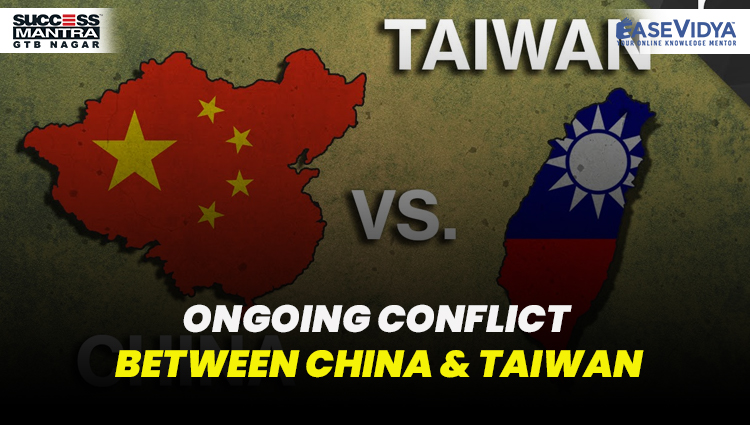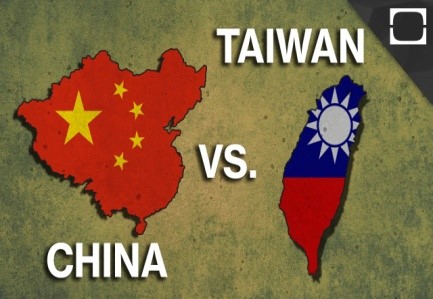
ONGOING CONFLICT BETWEEN CHINA AND TAIWAN
ONGOING CONFLICT B/W CHINA & TAIWAN
China could mount a full-scale invasion of Taiwan by 2025. This is the warning that Taiwan’s defence minister Chiu Kuo-cheng shared with the country’s parliament. Taipei & Beijing relationships have been strained for years, but the latest escalation comes from a series of air incursions by the Chinese military. Over the course of the past four days, Taiwan has reported the unauthorised entry of around 150 aircrafts, the first of which coincided with China’s National Day celebrations. Taiwan terms these as attempts to harass the island, which Beijing claims as its own. Taiwan however considers itself to be a sovereign nation.
The developments in the Indo-Pacific region are being watched warily by the international community. Neighbours in the region like Japan and Australia have asked the two nations to sort out the tensions via diplomacy, while the United States has condemned China’s actions.

Current Affairs Notes By Success Mantra Coaching Institute GTB Nagar Delhi CLICK HERE
CONFLICT BETWEEN CHINA AND TAIWAN (BACKGROUND)
China and Taiwan separated amid civil war in 1949 and China considers Taiwan part of its territory to be taken control of by force if necessary. But Taiwan's leaders say that Taiwan is a sovereign state. After decades of hostile intentions and angry rhetoric, relations between China and Taiwan started improving in the 1980s. China put forward a formula, known as "one country, two systems", under which Taiwan would be given significant autonomy if it accepted Chinese reunification. In Taiwan, the offer was rejected, but the government did relax rules on visits to and investment in China. There were also limited talks between the two sides' unofficial representatives, though Beijing's insistence that Taiwan's Republic of China (ROC) government is illegitimate prevented government-to-government contact. China's implementation of a national security law in Hong Kong in 2020 was seen by many as yet another sign that Beijing was becoming significantly more assertive in the region.
USA VIS-A-VIS CHINA OVER TAIWAN
- The Chinese government passed an Anti-Secession Law in 2005 that provides conditions under which China might employ non-peaceful means to prevent the permanent separation of Taiwan from mainland China. The USA as part of the Taiwan Relations Act (TRA) 1979, is required to assist Taiwan if coerced or attacked by China. Thus, the recent Chinese incursions and USA’s opposition to it are manifestations of this contradicting stand of the USA and China on Taiwan.
- USA’s Stand: The USA criticised the pattern of ongoing attempts by China to intimidate its neighbours, including Taiwan. It has urged China to cease its military, diplomatic, and economic pressure against Taiwan and instead engage in meaningful dialogue with Taiwan’s democratically elected representatives.
CHINA'S CONCERNS
- One China Policy challenged: This means that countries seeking diplomatic relations with the People's Republic of China (PRC, Mainland China) must break official relations with the Republic of China (ROC, Taiwan) and vice versa. The existent diplomatic relationship of the Taiwan and its membership in intergovernmental organizations challenges this policy:
- The ROC, Taiwan has diplomatic relations with 15 countries and substantive ties with many others such as Australia, Canada, EU nations, Japan and New Zealand. Besides, Taiwan has full membership in 38 intergovernmental organizations and their subsidiary bodies, including the World Trade Organization, Asia-Pacific Economic Cooperation, Asian Development Bank and Central American Bank for Economic Integration.

AGREEMENTS/EXERCISES COUNTERING CHINA
- Recently, the US has announced a new trilateral security partnership for the Indo-Pacific, between Australia, the UK and the US (AUKUS), which is also seen as an effort to counter China.
- Malabar Exercise (US, Japan, India and Australia) is also a major step towards building a sustainable Indo-Pacific coalition thereby addressing the massive strategic imbalance generated by an economically and militarily powerful China.
- Strategic and Defense Support to Taiwan by US: Taiwan has sought to improve its defenses with the purchase of US weapons, including upgraded F-16 fighter jets, armed drones, rocket systems and Harpoon missiles. A US aircraft carrier group led by the warship Theodore Roosevelt has entered the South China Sea to ensure freedom of the seas, and build partnerships that foster maritime security.

INDIA'S STAND ON THE ISSUE
Since 1949, India has accepted the “One China” policy that accepts Taiwan and Tibet as part of China. However, India uses the policy to make a diplomatic point, i.e., if India believes in “One China” policy, China should also believe in a “One India” policy. Even though India has stopped mentioning its adherence to One China policy in joint statements and official documents since 2010, its engagement with Taiwan is still restricted due to the framework of ties with China. India and Taiwan do not have formal diplomatic relations but since 1995, both sides have maintained representative offices in each other’s capitals that function as de facto embassies.
PRAVAHINI Current Affairs Notes By Success Mantra Coaching Institute GTB Nagar Delhi CLICK HERE
CONCLUSION
India and other powers must draw a redline for any Chinese effort to take Taiwan by force. After all, the Taiwan issue is not just a moral question of allowing the destruction of a successful democracy by a totalitarian State, or a question of international ethics where the principle of settling disputes peacefully is adhered to. In fact, the reason for drawing that line is not about Taiwan at all, but because of what the consequences of a Chinese invasion of Taiwan would be for India and the rest of Asia. The day after China’s invasion of Taiwan will mark a very different Asia, irrespective of the results of the invasion. Drawing a red line is not easy and may ultimately not work, but India and others at least need to try because of the stakes involved. One aspect of this is improving India’s ties with Taiwan, even if they stay short of recognising its independence. Others have argued for continuing with the growing economic relations and building on popular support for Taiwan in the wake of India’s troubles with China.
TEST YOURSELF
Q.1 Which of the following is a formula or policy put forward by China, under which Taiwan would be given significant autonomy if it accepted Chinese reunification?
- One China Policy
- China First Policy
- One country, two systems formula: ANSWER
- None of the above
Q.2 Consider the given statements & state which of the following is/are incorrect in reference to the above mentioned passage?
- China's implementation of a national security law in Hong Kong in 2020 was seen by many as yet another sign that Beijing was becoming significantly more assertive in the region & for Taiwan.
- China also objected to the recent campaign (posters and social media) in India wishing Taiwan “Happy National Day” (October 8th) and referring to it as a “country” or a “nation”.
- Only I follows
- Only II follows: ANSWER
- Both I & II follows
- Neither I nor II follows
Q.3 The United States of America as part of which of the following legislation, required to assist Taiwan if coerced or attacked by China?
- Taiwan Relations Act, 1979: ANSWER
- Taiwan's Security Act, 1981
- Taiwan Sovereign state Act, 1979
- None of the following
Q.4 After considering the given statements, state which of the following is/are correct in the reference to the historical background of China-Taiwan conflict?
- China and Taiwan separated amid civil war in 1945 and China considers Taiwan part of its territory to be taken control of by force if necessary.
- 'China First Policy' means that countries seeking diplomatic relations with the People's Republic of China (PRC, Mainland China) must break official relations with the Republic of China (ROC, Taiwan) and vice versa.
- China considers that Taiwan's Republic of China (ROC) government is illegitimate & prevented government-to-government contact: ANSWER
- None of the following
Q.5 Which of the following given statements is/are correct in the context of the India's stand over the China-Taiwan's conflict?
- Since 1949, India has accepted the “One China” policy that accepts Taiwan and Tibet as part of China.
- India and Taiwan do not have formal diplomatic relations but since 1995, both sides have maintained representative offices in each other’s capitals that function as de facto embassies.
- Taiwan has for long been a world leader in high-tech hardware manufacturing, and can contribute much to the “Make in India”, “Digital India” and “Smart Cities” campaigns
- I & III follows
- Only III follows
- I & II follows
- All of the above: ANSWER













0 Comment